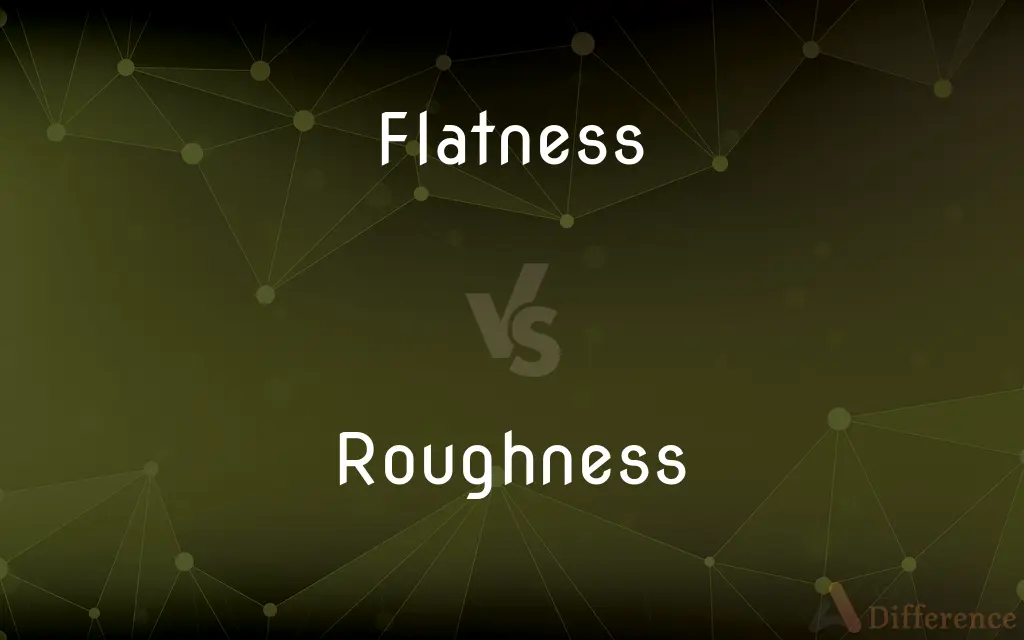Flatness vs. Roughness — What's the Difference?
By Maham Liaqat & Fiza Rafique — Updated on April 5, 2024
Flatness refers to the smoothness and evenness of a surface, indicating minimal deviations, while roughness measures the irregularities and texture, denoting the degree of surface variation.

Difference Between Flatness and Roughness
Table of Contents
ADVERTISEMENT
Key Differences
Flatness is a geometric attribute that describes how close a surface is to being perfectly flat, with minimal deviations across its extent. Roughness, on the other hand, pertains to the micro deviations or variations on a surface's texture.
While flatness is concerned with the overall evenness and uniformity of a surface, roughness focuses on the detailed texture and micro-level irregularities. For example, a surface can be very flat, indicating it doesn't deviate much from a perfect plane, but still have a high roughness due to fine textural features. Conversely, a surface with low roughness might appear smooth to the touch but could have poor flatness if it deviates significantly across its width or length.
In manufacturing and quality control, both flatness and roughness are critical. Flatness ensures that parts fit together correctly and function as intended, without gaps or misalignments. Roughness affects aspects like seal performance, lubrication retention, and overall aesthetics. Engineers and designers must specify both attributes to meet the performance requirements of their projects.
Different instruments and techniques are used to measure flatness and roughness, reflecting their distinct nature. Flatness measurements often involve tools like precision levels, optical flats, or coordinate measuring machines that can assess deviations across a surface. Roughness measurements, however, utilize profilometers or atomic force microscopy, focusing on the microscopic details of surface texture.
The control of flatness and roughness is essential for optimizing the performance and lifespan of mechanical components. Adjustments in manufacturing processes, such as changing cutting tools or parameters, can significantly influence these surface characteristics. Understanding the relationship between flatness and roughness allows for better material and process choices, ensuring components meet their intended functional and aesthetic standards.
ADVERTISEMENT
Comparison Chart
Definition
Measure of a surface's overall evenness and smoothness, with minimal deviations from a perfect plane.
Measure of a surface's texture, including micro deviations, peaks, and valleys.
Focus
Overall uniformity and deviation across the surface.
Micro-level texture and irregularities on the surface.
Measurement
Precision levels, optical flats, coordinate measuring machines.
Profilometers, atomic force microscopy.
Importance
Affects fit, function, and aesthetics of parts; crucial for assembly and functional performance.
Influences material properties like friction, wear resistance, and light reflection; impacts seal performance and aesthetics.
Compare with Definitions
Flatness
The condition of being level and even across a surface.
The flatness of the machine bed ensures accuracy during machining.
Roughness
Critical for functional and aesthetic qualities.
The roughness level on the sculpture was carefully controlled for visual effect.
Flatness
A criterion for quality control in manufacturing.
The flatness of each panel is inspected before assembly.
Roughness
Measured by the height of peaks and valleys.
The roughness of the road surface was assessed for safety.
Flatness
Measured by the deviation from a perfect plane.
The table's flatness was verified using a precision level.
Roughness
The texture or micro-irregularities on a surface.
Surface roughness affects the lubrication properties of gears.
Flatness
Essential for assembly and function of mechanical parts.
Flatness of the gasket surface is critical to prevent leaks.
Roughness
Influences friction and wear resistance.
The roughness of the bearing surface is optimized for durability.
Flatness
A geometric characteristic describing the uniformity of a surface.
Achieving the required flatness for the optical component was challenging.
Roughness
A factor in material selection and process parameters.
Adjusting the milling speed can reduce surface roughness.
Flatness
Having a smooth, even surface
A flat field.
Roughness
Having a surface marked by irregularities, protuberances, or ridges; not smooth
Planed the board so it was no longer rough.
Flatness
Having a relatively broad level surface in relation to thickness or depth
A flat box.
Roughness
Coarse or shaggy to the touch
A rough scratchy blanket.
Flatness
Being in horizontal position; lying down
Flat on his back.
Roughness
Difficult to travel over or through
The rough terrain of the highlands.
Flatness
Being without slope or curvature
A flat line on a chart.
Roughness
Characterized by violent motion; turbulent
Rough waters.
Flatness
Having a low heel or no heel
Flat shoes.
Roughness
Difficult to endure or live through, especially because of harsh or inclement weather
A rough winter.
Flatness
Free of qualification; absolute
A flat refusal.
Roughness
Unpleasant or difficult
Had a rough time during the exam.
Flatness
Fixed; unvarying
A flat rate.
Roughness
Characterized by or done with violence or forcefulness
A sport noted for rough play.
A package that received rough handling.
Flatness
Lacking interest or excitement; dull
A flat scenario.
Roughness
Boisterous, disorderly, or given to violence
Ran with a rough crowd.
Flatness
Lacking in flavor
A flat stew that needs salt.
Roughness
Characterized by violence or crime
Lives in a rough neighborhood.
Flatness
Having lost effervescence or sparkle
Flat beer.
Roughness
Lacking polish or finesse
Rough manners.
Flatness
Deflated. Used of a tire.
Roughness
Harsh to the ear
A rough raspy sound.
Flatness
Electrically discharged. Used of a storage battery.
Roughness
Being in a natural state
Rough diamonds.
Flatness
Of or relating to a horizontal line that displays no ups or downs and signifies the absence of physiological activity
A flat electroencephalogram indicates a loss of brain function.
Roughness
Not perfected, completed, or fully detailed
A rough drawing.
Rough carpentry.
Flatness
Of or relating to a hierarchy with relatively few tiers or levels
A flat organization chart.
Roughness
The surface or part of something that is uneven or coarse
Felt the rough of his chin.
Flatness
Commercially inactive; sluggish
Flat sales for the month.
Roughness
Rugged overgrown terrain.
Flatness
Unmodulated; monotonous
A flat voice.
Roughness
(Sports) The area of a golf hole in which the grass is left unmowed or is cut to a length longer than that of the fairway.
Flatness
Lacking variety in tint or shading; uniform
"The sky was bright but flat, the color of oyster shells" (Anne Tyler).
Roughness
A disorderly, unrefined, or unfinished state.
Flatness
Not glossy; matte
Flat paint.
Roughness
A difficult or disagreeable aspect or condition of something
Observed politics in the rough when working as an intern on Capitol Hill.
Flatness
Being below the correct pitch.
Roughness
A person given to violent or disorderly behavior; a rowdy.
Flatness
Being one half step lower than the corresponding natural key
The key of B flat.
Roughness
To treat roughly or with physical violence
Roughed up his opponent.
Flatness
Designating the vowel a as pronounced in bad or cat.
Roughness
(Sports) To treat (an opposing player) with unnecessary roughness, often in violation of the rules
Was ejected from the game for roughing the passer.
Flatness
(Nautical) Taut. Used of a sail.
Roughness
To prepare or indicate in an unfinished form
Rough out a house plan.
Flatness
Level with the ground; horizontally.
Roughness
In a rough manner; roughly
The engine began to run rough and faltered.
Flatness
On or up against a flat surface; at full length.
Roughness
The property of being rough, coarseness.
The roughness of the road made me wonder if my car would fall apart.
Flatness
So as to be flat.
Roughness
Something that is rough; a rough spot.
Flatness
Directly; completely
Went flat against the rules.
Flat broke.
Roughness
(US) Roughage; coarse fodder.
Flatness
Exactly; precisely
Arrived in six minutes flat.
Roughness
(Scotland) Abundance, especially of food.
Flatness
(Music) Below the intended pitch.
Roughness
A measure of how rough something is, such as a surface
The surface roughness was low.
Flatness
(Business) Without interest charge.
Roughness
The quality or state of being rough.
Flatness
A flat surface or part.
Roughness
A texture that is not smooth but is irregular and uneven
Flatness
Often flats A stretch of level ground
Salt flats.
Roughness
Harsh or rough to the ear
Flatness
A shallow frame or box for seeds or seedlings.
Roughness
An unpolished unrefined quality;
The crudeness of frontier dwellings depressed her
Flatness
A movable section of stage scenery, usually consisting of a wooden frame and a decorated panel of wood or cloth.
Roughness
Used of the sea
Flatness
A flatcar.
Roughness
Rowdy behavior
Flatness
A deflated tire.
Roughness
The formation of small pits in a surface as a consequence of corrosion
Flatness
A shoe with a flat heel.
Flatness
A large flat piece of mail.
Flatness
A horse that competes in a flat race. Also called runner.
Flatness
A sign (♭) used to indicate that a note is to be lowered by a semitone.
Flatness
A note that is lowered a semitone.
Flatness
(Football) The area of the field to either side of an offensive formation.
Flatness
To make flat; flatten.
Flatness
(Music) To lower (a note) a semitone.
Flatness
To sing or play below the proper pitch.
Flatness
The state of being flat
Flatness
The state of being two-dimensional; planar : planarity
Flatness
The state of being bland : dullness
Flatness
Mattness, the quality of a painted surface which scatters or absorbs the light falling on it, so as to be substantially free from gloss or sheen
Flatness
(oenology) Lack of bouquet and freshness of a wine, through too much aeration or infection with film yeasts
Flatness
(statistics) slim-tailedness or platykurticity
Flatness
The quality or state of being flat.
Flatness
Eveness of surface; want of relief or prominence; the state of being plane or level.
Flatness
Want of vivacity or spirit; prostration; dejection; depression.
Flatness
Want of variety or flavor; dullness; insipidity.
Flatness
Depression of tone; the state of being below the true pitch; - opposed to sharpness or acuteness.
Flatness
The property of having two dimensions
Flatness
The property of having little or no contrast; lacking highlights or gloss
Common Curiosities
What is the difference between flatness and roughness?
Flatness measures a surface's overall evenness, while roughness assesses the texture and micro-level irregularities of a surface.
Can a surface be flat but still rough?
Yes, a surface can be flat, indicating minimal overall deviations, but still have a high roughness due to its fine-textured peaks and valleys.
How are flatness and roughness measured?
Flatness is measured with tools like precision levels and optical flats, while roughness is quantified using profilometers or atomic force microscopy.
How do flatness and roughness affect product quality?
They impact the fit, function, aesthetics, and performance of products, influencing aspects like seal integrity, lubrication retention, and overall operational efficiency.
Is it possible to control flatness and roughness separately?
While related, flatness and roughness can be controlled independently through specific manufacturing practices and quality control measures.
Why are both flatness and roughness important in manufacturing?
They are crucial for ensuring that parts fit correctly, function as intended, and meet desired material properties like friction and wear resistance.
Can manufacturing processes affect flatness and roughness?
Yes, changes in manufacturing processes, such as tool selection or machining parameters, can significantly influence both flatness and roughness.
How do environmental factors affect flatness and roughness?
Environmental factors, such as temperature and humidity, can cause material expansion or contraction, potentially affecting both flatness and roughness.
Do flatness and roughness specifications vary by industry?
Yes, different industries have varying standards and tolerances for flatness and roughness based on the specific requirements and applications of their products.
Can surface treatments improve flatness and roughness?
Surface treatments, like grinding, polishing, or coating, can significantly improve both flatness and roughness by modifying the surface characteristics.
Share Your Discovery

Previous Comparison
Perihelion vs. Aphelion
Next Comparison
Bolsheviks vs. MensheviksAuthor Spotlight
Written by
Maham LiaqatCo-written by
Fiza RafiqueFiza Rafique is a skilled content writer at AskDifference.com, where she meticulously refines and enhances written pieces. Drawing from her vast editorial expertise, Fiza ensures clarity, accuracy, and precision in every article. Passionate about language, she continually seeks to elevate the quality of content for readers worldwide.
















































